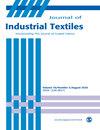研究微颗粒对复合材料层压板机械性能和损坏失效的影响
IF 2
4区 工程技术
Q1 MATERIALS SCIENCE, TEXTILES
引用次数: 0
摘要
由于复合材料具有公认的机械性能和高强度重量比,因此其应用越来越广泛。本研究旨在提高复合材料层压板的机械性能和断裂韧性。研究采用了多种类型的织物,如玻璃纤维、碳纤维、凯夫拉纤维和微颗粒,通过真空灌注法制造复合材料层压板。通过拉伸和弯曲强度测试,对所提出的层压板的机械性能进行了评估。此外,还进行了冲击强度测试,以检验其动态性能。结果表明,与不含微颗粒的复合材料相比,含有微颗粒的编织层压材料(如玻璃编织、碳编织和凯夫拉编织复合材料)具有更好的拉伸性能。例如,含有填料的玻璃、碳和凯夫拉纤维织物的杨氏模量分别提高了约 5%、6% 和 13%。此外,加入热塑性颗粒的玻璃、碳和凯夫拉纤维层压板也获得了更高的冲击强度和断裂韧性。例如,含有填料的玻璃、碳和凯夫拉纤维复合材料样品的断裂韧性分别提高了约 24%、17% 和 14%。此外,挠曲破坏载荷和破坏失效模式的数值模拟结果在定性和定量方面都与实验结果一致。本文章由计算机程序翻译,如有差异,请以英文原文为准。
Studying the influence of micro-particles on the mechanical performance and damage failures of composite laminates
Composite materials are increasingly used in a broad range of applications due to their recognizable mechanical properties and the high strength-to-weight ratio. The aim of the current study is to improve the mechanical properties and fracture toughness of composite laminates. Several types of fabrics, such as glass, carbon, and Kevlar, and micro-particles are adopted to create composite laminates via the vacuum infusion method. The mechanical performances of the proposed laminates were evaluated via tensile and flexural strength tests. Moreover, the impact strength tests were conducted to examine their dynamic performances. Results showed that woven laminates such as glass woven, carbon woven, and Kevlar woven composites with micro-particles revealed better tensile properties compared with those without micro-particles. For instance, enhancement in the Young’s modulus with around 5%, 6%, and 13% were resulted from the glass, carbon, and Kevlar fabrics with fillers, respectively. Furthermore, higher impact strength and fracture toughness were obtained from the laminates of glass, carbon and Kevlar with inclusion of thermoplastic particles. For example, the glass, carbon and Kevlar fabrics composites with fillers samples showed improvement in the fracture toughness with around 24%, 17% and 14%, respectively. In addition, numerical simulation findings of flexural failure load and damage failure modes were in accordance with experimental results both qualitatively and quantitatively.
求助全文
通过发布文献求助,成功后即可免费获取论文全文。
去求助
来源期刊

Journal of Industrial Textiles
MATERIALS SCIENCE, TEXTILES-
CiteScore
5.30
自引率
18.80%
发文量
165
审稿时长
2.3 months
期刊介绍:
The Journal of Industrial Textiles is the only peer reviewed journal devoted exclusively to technology, processing, methodology, modelling and applications in technical textiles, nonwovens, coated and laminated fabrics, textile composites and nanofibers.
 求助内容:
求助内容: 应助结果提醒方式:
应助结果提醒方式:


